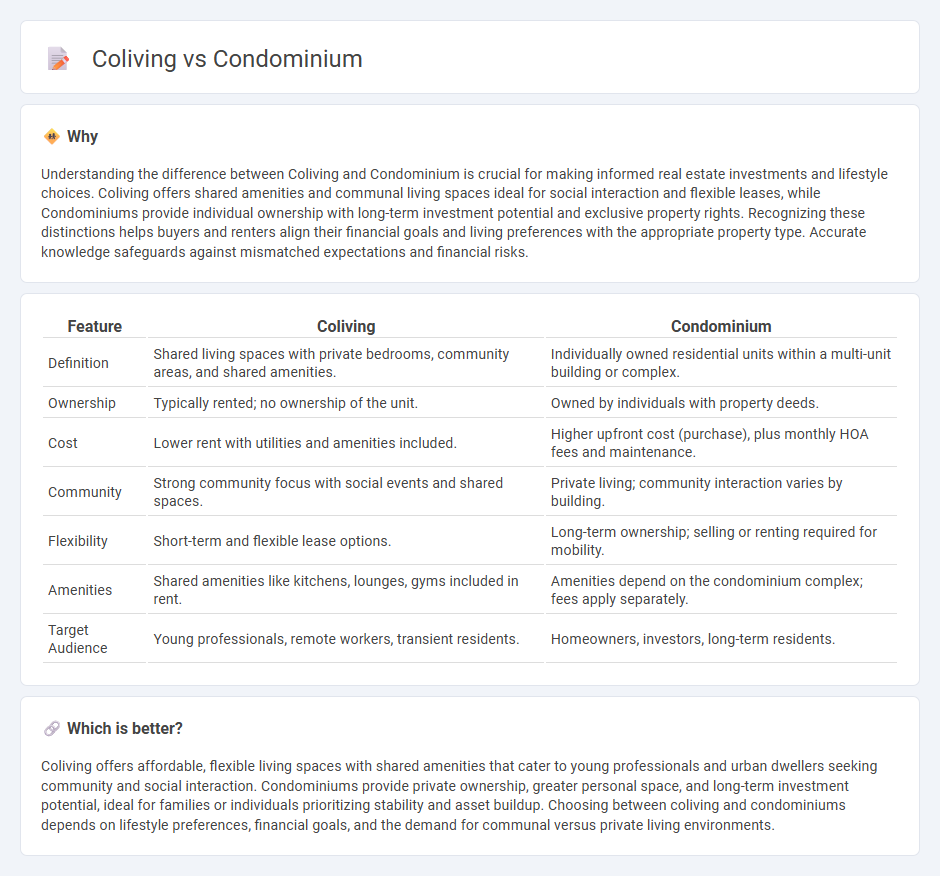
Coliving spaces offer affordable, flexible housing solutions with shared amenities and communal living designed for modern urban residents, contrasting with traditional condominiums that provide private ownership and individual units with exclusive facilities. While condominiums emphasize long-term investment and private space, coliving focuses on social interaction, convenience, and reduced living costs. Explore more to understand which housing model best suits your lifestyle and financial goals.
Why it is important
Understanding the difference between Coliving and Condominium is crucial for making informed real estate investments and lifestyle choices. Coliving offers shared amenities and communal living spaces ideal for social interaction and flexible leases, while Condominiums provide individual ownership with long-term investment potential and exclusive property rights. Recognizing these distinctions helps buyers and renters align their financial goals and living preferences with the appropriate property type. Accurate knowledge safeguards against mismatched expectations and financial risks.
Comparison Table
| Feature | Coliving | Condominium |
|---|---|---|
| Definition | Shared living spaces with private bedrooms, community areas, and shared amenities. | Individually owned residential units within a multi-unit building or complex. |
| Ownership | Typically rented; no ownership of the unit. | Owned by individuals with property deeds. |
| Cost | Lower rent with utilities and amenities included. | Higher upfront cost (purchase), plus monthly HOA fees and maintenance. |
| Community | Strong community focus with social events and shared spaces. | Private living; community interaction varies by building. |
| Flexibility | Short-term and flexible lease options. | Long-term ownership; selling or renting required for mobility. |
| Amenities | Shared amenities like kitchens, lounges, gyms included in rent. | Amenities depend on the condominium complex; fees apply separately. |
| Target Audience | Young professionals, remote workers, transient residents. | Homeowners, investors, long-term residents. |
Which is better?
Coliving offers affordable, flexible living spaces with shared amenities that cater to young professionals and urban dwellers seeking community and social interaction. Condominiums provide private ownership, greater personal space, and long-term investment potential, ideal for families or individuals prioritizing stability and asset buildup. Choosing between coliving and condominiums depends on lifestyle preferences, financial goals, and the demand for communal versus private living environments.
Connection
Coliving and condominiums share a common foundation in urban residential real estate, focusing on maximizing space utilization and community living. Coliving spaces often operate within condominium buildings, leveraging shared amenities and offering flexible lease terms that attract young professionals and remote workers. Both models emphasize social interaction, affordability, and convenience, driving innovation in property management and urban housing solutions.
Key Terms
Ownership Structure
Condominium ownership provides individuals with full legal ownership of a specific unit and shared ownership of common areas, offering long-term property rights and the ability to sell or lease independently. Coliving arrangements typically involve renting a private bedroom with shared communal spaces under a single lease agreement, with no ownership rights or investment benefits. Explore the key differences in ownership structure to determine which housing model aligns best with your lifestyle and financial goals.
Shared Amenities
Condominium residents typically enjoy privately owned units with access to shared amenities such as gyms, pools, and lounges, fostering a balance between privacy and community. Coliving spaces emphasize fully furnished private rooms coupled with extensive communal areas, including coworking spaces, kitchens, and social lounges, designed to enhance social interaction and flexibility among residents. Explore the distinctive features and benefits of shared amenities in both living arrangements to find the ideal fit for your lifestyle.
Lease Agreement
Condominium lease agreements typically involve individual ownership with long-term leases, requiring detailed terms on maintenance, fees, and tenant responsibilities. Coliving lease agreements emphasize flexible, short-term rentals with shared spaces and community rules designed for collaborative living. Explore the key differences in lease agreements to determine which housing option aligns best with your needs.
Source and External Links
Condominium - A condominium is a type of multi-unit complex where each unit is individually owned, with common areas managed by a homeowners association (HOA) through a set of governing documents like the condominium declaration and bylaws.
Condominium - Condominiums are residential common interest developments where each member owns a unit, with membership in a governing association that manages shared areas and sets rules for unit use.
What is a condo? - A condominium is a residential complex with individually owned units, where owners are responsible for their units and pay fees to a homeowners association for shared space maintenance.
 dowidth.com
dowidth.com